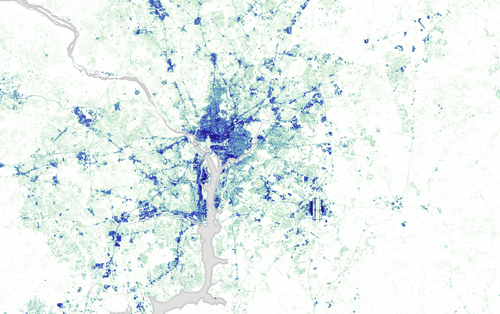See how much more land is paved now than in 1984
In 2010, there was much more pavement covering more of the region than 26 years earlier. These images from the University of Maryland, highlighted by NASA’s Earth Observatory blog, show the change.


The region has grown, in population and in economic activity, and some new impervious surface is a consequence of that. However, the region can grow in ways that minimize impervious surface, by building larger buildings in the core and transit-oriented development around Metro stations. Or it can grow in more environmentally destructive ways, through sprawl.
Some of this new impervious surface reflects already urban places getting denser. That’s a good thing; by adding a little impervious surface in Arlington or along Connecticut Avenue, for example, the region saves a greater amount from being built outside the Beltway.
But much of this new surface isn’t responsible development. The NASA post points this out, saying,
In addition to the widening of the Beltway, notice how pavement has proliferated in Fairfax and Loudoun counties in Virginia and Prince George’s and Montgomery counties in Maryland. The District of Columbia was already densely developed in 1984, so the changes there are less noticeable.
The map also doesn’t even zoom far enough out to show places like Frederick, Howard, Prince William, Fauquier, and Stafford counties, where the change is even more dramatic, and where even less of the new pavement is in places that are walkable or oriented to transit.
This is an effect of “height-itis”
Week after week, local boards in many jurisdictions make decisions, like taking housing away from the Georgetown Day School project in Tenleytown, which remove a little potential housing in the core. Those choices don’t keep even one square foot of land unpaved (and even if they did, it wouldn’t be worth the tradeoff), but they do push a little more growth out to where it affects maps like this.
Our region can protect natural resources, but not until people are willing to make them a priority. Until then, this trend will continue.
